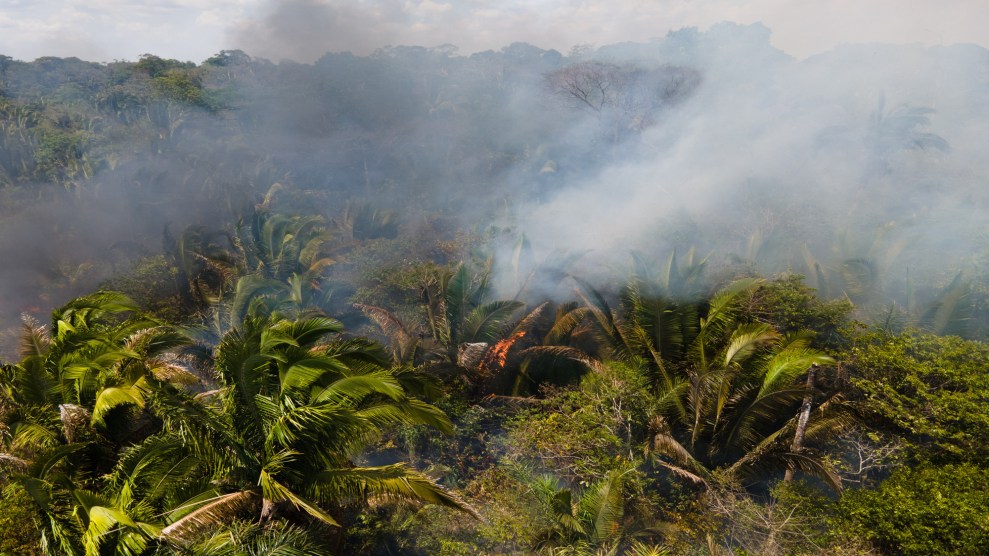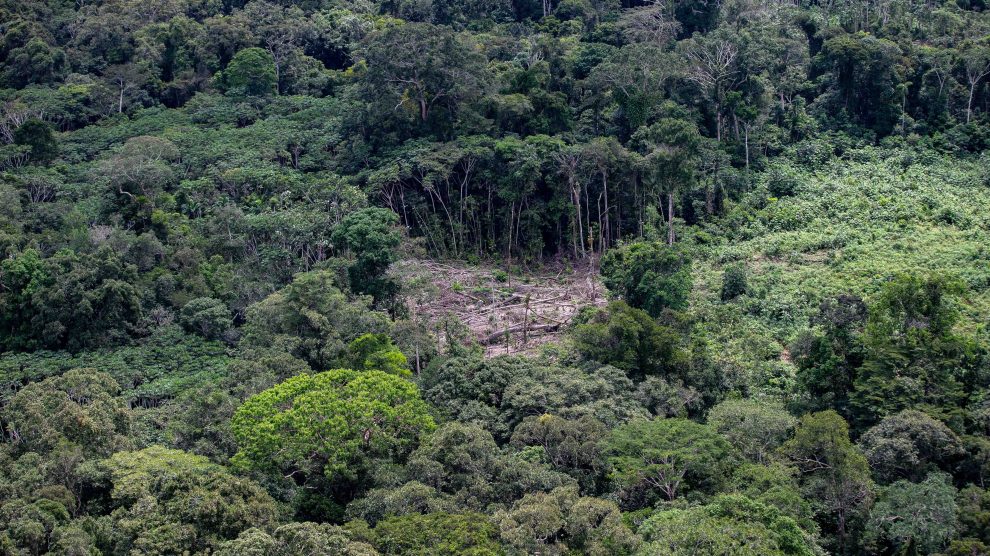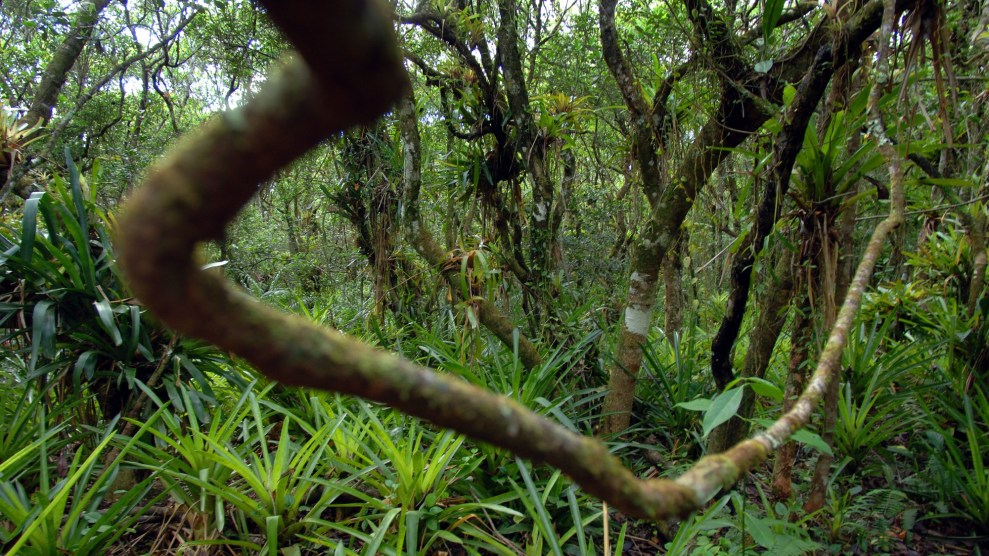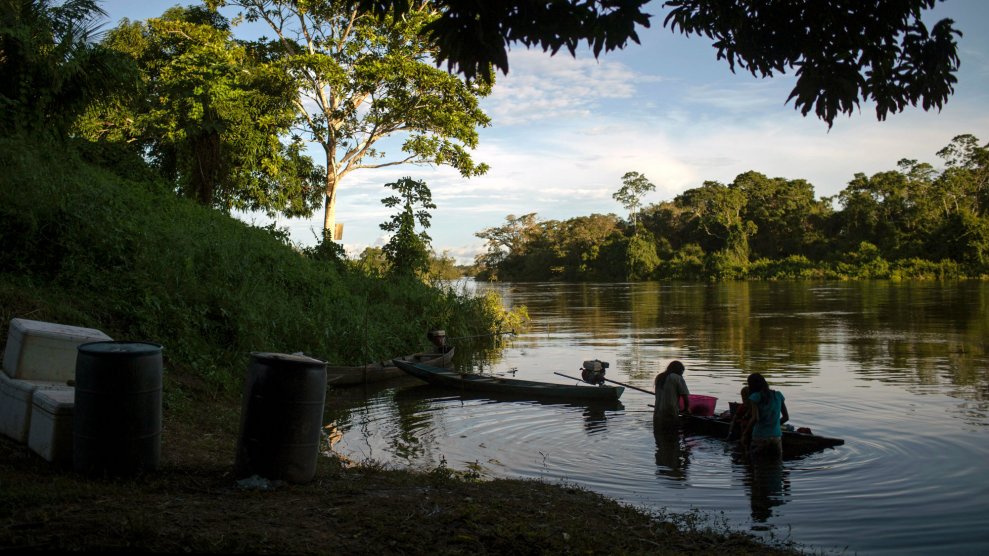
Burning of the Amazon rainforest. Fernando Souza/ZUMA
This story was originally published by the Guardian and is reproduced here as part of the Climate Desk collaboration.
I thought it was a blood moon at first. The dark orange glow appeared at dusk on the far side of the shimmering silver band that is the Xingu River. It was just before 8pm, after the parrots had squawked back to their nests and the insects and frogs were noisily starting the forest nightshift. A flash of lightning from a cloud appeared above almost the same location but the rest of the sky was clear. How could there be a storm? I peered more intently and took a photograph that I could magnify. And there was the answer—a fire, which grew fiercer as I watched, the flames spreading sideways and upwards, flickering red and yellow, billowing smoke into the sky, sparking flashes of lightning every couple of minutes.
I felt sick to the stomach. The Amazon rainforest was being destroyed in front of my eyes. I have been writing about the climate crisis for 16 years, always with a sense of horror but until now, mostly with a sense of distance. This was the first time I had seen it from my home, and it was stranger than I expected. I had not realized until that moment that fire can create its own lightning storms, by creating pyrocumulonimbus, which scientists describe as “the fire-breathing dragon of clouds.”
There was no immediate danger—the fire was several miles away on the other side of one of the world’s biggest rivers—but it felt personal. More than 90 percent of fires in the Amazon are started deliberately to clear trees so the land can be used for cattle ranching or crop cultivation. That meant this arson attack against nature was almost certainly carried out by one of my neighbors. I knew it was probably illegal and that, according to climate science, it would nudge the world’s biggest rainforest that much closer to an irreversible tipping point. But there was nothing I could do except watch. The chances of anyone else lifting a finger while Jair Bolsonaro was Brazil’s president were next to zero.
This was on August 27 . The next morning I learned there were several fires in the rainforest that night. In fact, this was one of the most devastating nights for the Amazon in a decade. Landowners and land-grabbers were rushing to burn with impunity before a presidential election that the polls showed was likely to result in a change of power. August, September, and October were months of fire, a human-made season wedged between the driest point of summer and the onset of the winter monsoons. A haze of charred vegetation shrouded many parts of the rainforest for weeks. My asthma returned for the first time in nine months. Viewed from the forest, the contest between Bolsonaro and his main challenger, Luiz Inácio Lula da Silva, was not about tax rises or government spending—it was life or death.
I moved to the Amazon last December. The journey itself was eye-opening. I travelled here with my nine-month-old dog, Frida, who wasn’t allowed on the last leg of the plane journey from Belem to Altamira so we had to do that 500-mile stretch by car along the dusty Trans-Amazonian highway.
This road, the BR230, was the starting point for the past half-century of destruction. When the first section opened in 1972 the president of Brazil’s military dictatorship, Gen. Emílio Garrastazu Médici, marked the occasion in Altamira by cutting down a giant Brazil nut tree to symbolize the conquest of nature. The road was designed to bring in a wave of settlers. “Land without men for men without land” was the misleading slogan of the regime, which had trampled over and often killed the Indigenous communities that had lived there for millennia. The road has since become a vector for land clearance and violence.
As Frida and I passed through, I could see the bio-rich primary forest on the side of the road had been replaced by soy and cacau monocultures. The Tocantins and Xingu rivers were dammed by huge hydroelectric at Tucuruí and Belo Monte. Again and again, along the 12-hour drive, the hillsides were stripped of trees and replaced with pastures scattered with white cows. Beef consumes more of the forest than any other commodity. There are now 90 million cows in the Amazon, grazing on an area of cleared land the size of France.
Few outside Brazil have heard of our destination, Altamira, but it is one of the biggest municipalities on the planet with a surface area of 62,000 square miles, making it larger than half of the world’s countries. It is in the state of Pará, which is the main exporter of cattle and gold in the Amazon, and as a result suffers the worst deforestation and the deadliest violence.
Like all frontier towns, Altamira has thrived on the destruction of nature, which has accelerated rapidly in the past five decades. Most of the land used to be covered in forest occupied by Indigenous communities, but waves of invasion have brought ever greater threats in the name of colonization, civilization, or development. First came the Jesuit missionaries in the 18th century, followed by the rubber barons in the 19th, then the big agricultural companies and the road and dam builders in the 20th. Today, it is primarily a cowboy and mining town, with a parade each November of hundreds of ranchers riding through the streets on horseback. In the hardware store, the staff shout out greetings to recognized customers, “Hey, garimpeiro (gold prospector)!”
I remember my first visit here eight years ago to cover the construction of the Belo Monte dam, the biggest hydroelectric plant in the Amazon. “The vast construction site is like something out of Mordor—an immense wall of stone, steel and concrete that towers above a blasted plain,” I wrote at the time, when I thought, rather sniffily, “Who would want to live here?”
The answer, it seems, is me. To my surprise and delight, I have now lived in the rainforest for 12 months. During this time, I have learned much more intimately that, instead of living as part of nature as we should, much of humanity is now at war with it. Fire is the main weapon against the forest; guns and intimidation against its protectors, the Indigenous communities.
Two friends, the land and environment activists Erasmo and Natalha Theofilo, are in hiding for the fifth time since Bolsonaro took power after multiple death threats to them and their children. Another friend, the first woman to be an Indigenous chief, Juma Xipaya, came to dinner with a bodyguard because she, too, has a price on her head after speaking out against illegal mines.
To be in the Amazon in 2022 is to live between a tipping point that humanity must avoid and a turning point that we must invent. The world’s rainforest has degraded perilously close to a stage where it can no longer regenerate. As more trees are cleared, the forest is less able to produce its own rain. It starts to dry out, to become more vulnerable to fire and lightning strikes, until it changes into another ecosystem entirely, a savannah, which is less biodiverse, less capable of storing carbon, less powerful in generating the rainfall and storms that keep weather systems moving.
This is already happening along the arc of deforestation in the south and south-east Amazon, where the forest is turning to savannah as it emits more carbon than it absorbs. The rest of the rainforest is heading in the same direction: 17 percent has now been cleared and another 17 percent degraded. Scientists estimate the tipping point will occur when 20 percent to 25 percent of the Amazon is lost, which, at the current rate of ecocide, is more likely to be years rather than decades away.
Being here helps me understand a little better why the forest is sacrificed. Pará is one of the poorest states in Brazil, with a per capita income half the national average, and with dire inequality. Since the opening of the Trans-Amazonian highway there have been four types of settlers in Altamira. First there is an already wealthy white elite, who were invited to migrate and given substantial landholdings on condition they started agricultural businesses that would benefit the town’s economy. Instead, many of them simply kept the property for themselves, became fazendeiros (farmers), and set about expanding their empires through illegal and often violent land grabs.
The second group are white settlers from the south of Brazil who were given state support and cheap credit, which has enabled some of them to thrive. These two groups show little desire to be part of the forest, or to protect it. To them it is “the other,” either a threat or something to exploit. When they acquire a plot of land, their first step is always to “clean” it, which means destroying all traces of life with bulldozers. This creates a semi-sterile perimeter, which can be fenced off and grassed over.
About 70 percent of this illegally cleared land is then opened up for cattle ranches. It is these two groups that thrived when Bolsonaro and his ministers gutted the forest protection and Indigenous agencies, which led to a surge of invasions by land-grabbers, illegal miners, loggers, ranchers, and organized crime gangs. These are the people who trot through the streets on horseback during the annual cowboy parade. These are the customers I shop with at the hardware store, which does a booming trade in chainsaws and gold-panning equipment. These are the listeners of Sertanejo, the country music that has pushed samba and funk aside to dominate the Brazilian music industry. These are also the diehard Bolsonarists, who drive through town in their SUVs with a Brazil flag emblazoned on their bonnet.
But Altamira is also a base for those seeking a turning point for social equality and the environment. The third group of residents are descendants of people from the poorer north-east of Brazil, who either arrived as rubber tappers a century ago, or took their chances when the Trans-Amazonian was opened. Many of this group are afro-Brazilians, who were given little or no state support to settle in their new homes. They either work for the wealthy or fend for themselves by farming or mining in more remote areas. Many are under the sway of the evangelical church and criminal organizations, neither of which show any inclination to value the forest. But social activists, such as Daniela Silva, and artists such as Joaka Barros and Soll, are aiming to change this by reconnecting the young from poor urban communities with nature, through rap, art and visits.
They often find common cause with the fourth group: middle-class liberals from São Paulo and other cities who move to Altamira as academics, lawyers, medical professionals or conservation workers. Bold thinkers are looking for a new way of doing things. They include the human rights campaigner Antónia Melo, who led much of the resistance against the Belo Monte dam; doctors such as Erika Pellegrino, who are trying to use medicine to strengthen the remote communities who protect the forest; legal experts like Thais Santi, who are building new legal precedents of ecocide; and entrepreneurs such as Marcelo Salazar, who is searching for new business models to gather and market brazil nuts, acai, babassu oil, and other sustainably produced forest products.
Switching to a new model, something more natural, sustainable and fairer for future generations and other species, requires persistence and patience. That does not come easy, as I have learned in our small community, which is divided between those who are environmentally progressive and those who want to follow the path of carbon capital development that the world has been on for the past 250 years and which has brought incredible advances for human wellbeing at the expense of everything else. The argument between the two, which has manifested in several heated community meetings, is a microcosm of the directions that Brazil and the world are being pulled in.
For the past four years, the farmers have had the upper hand. For anyone who cares about the Amazon, this has been a horrendous period. Bolsonaro and his ministers dismantled much of the forest protection machinery that had been built up over the previous three decades, leading to a 60 percent rise in the rate of deforestation. Meanwhile, Brazil’s congress pushed forward with a package of bills to legitimize land thefts, weaken environmental licensing of new projects, and permit mining inside Indigenous territory. Narco-trafficking gangs have expanded their presence in the forest and started supplying cocaine to remote riverside communities.
Amid this moral and physical haze, the election victory of Lula was a gasp of fresh air. But can he rein back the destructive forces unleashed by Bolsonaro? It will not be easy and it will not be cheap. Tens of thousands of illegal miners will have to be relocated and retrained. The forest communities they have co-opted into land clearance, alcoholism, and prostitution will need support and their traditional practices treated with more respect. The Brazilian economy, which has become ever more dependent on agriculture and mining, will need alternative ways to generate income. Lula will have to find a way to work with a hostile congress and a sceptical agricultural sector, while strengthening forest protection and Indigenous rights. All of this will require one thing that has not happened since the first European colonizers set foot on this continent—the outside world will need to value the forest more alive than dead.
One way or another, this year has to be a turning point. With the firestorm on the horizon, I have seen more than enough of paradise lost. The wild abyss of the Amazon can not go on as it is. The womb of nature must not become her grave.
















